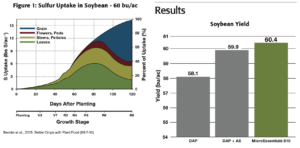OVERVIEW
- Diammonium phosphate (DAP) is a common phosphorus source used on soybean.
- New university research highlights the need for sulfur (S) management on soybean due to higher grain yields and lower atmospheric deposition. These data also emphasize the need for availability during both vegetative and reproductive growth. (See Figure 1)
- MicroEssentials S10 supplies multiple nutrients fused into one nutritionally balanced granule, providing uniform nutrient distribution, increased nutrient uptake, and season-long S availability.
TRIAL DETAILS
Locations and Crop Management:
CROP: Soybean (Glycine max)
YEARS: 2017-2019
LOCATIONS: 19 trials – AR, IL, IN, MI, OH, ON, WI
DATA SOURCE: Field studies conducted by independent third-party researchers.
EXPERIMENTAL DESIGN: Small-plot RCBD with 4 replications.
CROPPING CONDITIONS:
• All trials conformed to local cropping practices
P Rate: 40 lbs P₂O₅/ac applied as DAP (18-46-0) or MicroEssentials S10 (12-40-0-10S)
S Rate: 10 lbs S/ac from AS or MicroEssentials S10
K Rate: As required by soil test
Application Timing: Spring Preplant
Application Method: Broadcast Incorporated
RESULTS

SUMMARY
- Soybean yields increased with the addition of S.
- Averaged across 19 trials from 2017-19, MicroEssentials S10 increased soybean yield by 2.3 bu/ac over DAP and 0.5 bu/ac over DAP+AS.
- Higher soybean yields achieved by using MicroEssentials S10 demonstrates the value of uniform nutrient distribution, increased nutrient uptake, and season-long S availability (sulfate + elemental).
- Access additional yield data, ROI calculators, and resources at MicroEssentials – Performance.